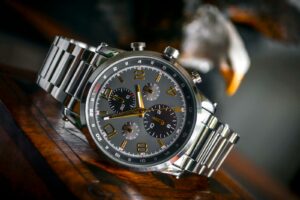In the world of luxury watches, maintaining your prized timepieces is just as crucial as acquiring them. Whether you own a Patek Philippe, Rolex, or any other luxury watch brand, proper care ensures that your investment retains its value and functionality for years to come. In this comprehensive guide, we’ll delve into the essential aspects of premium watch maintenance, covering everything from regular cleaning to servicing intervals and beyond.
Tips for Premium Watch Maintenance
1. Understanding Your Watch
Before delving into maintenance tips, it’s crucial to understand your watch thoroughly. Familiarize yourself with its features, functions, and limitations by reading the manufacturer’s manual. Each luxury timepiece is unique, and knowing its intricacies will guide you in caring for it appropriately.
2. Regular Cleaning
Regular cleaning is paramount to prevent dirt, dust, and grime buildup, which can affect your watch’s appearance and performance. Use a soft cloth to gently wipe down the watch case, bracelet, and dial. For water-resistant watches, you can rinse them under lukewarm water and dry them thoroughly afterward.
3. Storing Properly
Proper storage is essential to protect your high-end timepieces from dust, moisture, and other harmful elements. Invest in a quality watch box or case to keep your watches safe when they’re not adorning your wrist. Store them in a cool, dry place away from direct sunlight to avoid discoloration and damage.
4. Servicing Regularly
Regular servicing by an authorized service center or reputable watchmaker is crucial for maintaining your watch’s accuracy and functionality. Follow the manufacturer’s recommendations for service intervals, typically every three to five years for mechanical watches. During servicing, the watchmaker will inspect and lubricate the movement, replace worn parts, and ensure that your timepiece is in optimal condition.
5. Avoiding Water Exposure
While some luxury watches boast impressive water resistance, it’s essential to avoid exposing them to water unnecessarily. Remove your watch before swimming, showering, or engaging in water-related activities, as prolonged exposure can compromise its seals and lead to costly repairs.
6. Handling with Care
Handle your luxury watch with care to prevent scratches, dents, and other damage. Avoid wearing it during high-impact activities or when working with machinery. When setting the time or winding an automatic watch, do so gently to avoid stressing the movement.
7. Be Mindful of Magnets
Strong magnetic fields can disrupt your watch’s movement, affecting its accuracy. Avoid placing your watch near magnetic objects such as speakers, smartphones, or magnetic closures. If you suspect your watch has been exposed to magnets, have it demagnetized by a professional watchmaker.
8. Insure Your Investment
Finally, protect your investment by insuring your luxury watches against loss, theft, or damage. Reputable insurance providers offer specialized coverage for high-end timepieces, providing you with peace of mind knowing that your valuable assets are protected.
Understanding Your Watch Materials
When it comes to luxury watches, understanding the materials they’re crafted from is crucial for proper maintenance. From stainless steel to precious metals like gold and platinum, each material has its unique characteristics and requires specific care.
Luxury watch owners are often proud of the craftsmanship and attention to detail that go into creating their timepieces. Most luxury watchmaking companies meticulously select materials known for their durability, aesthetics, and longevity. For instance, Rolex is renowned for its use of 904L stainless steel, known for its resistance to corrosion and scratches, while Patek Philippe incorporates precious metals like 18K gold into their designs for a touch of elegance.
Whether your watch features a stainless steel case or a gold bracelet, it’s essential to understand its limits and tailor your maintenance routine accordingly. Stainless steel is known for its robustness, but it’s not immune to scratches and dings. On the other hand, gold is softer and more prone to wear, requiring extra care to prevent damage.
Regular maintenance is key to preserving the appearance and performance of your luxury watch, regardless of the materials it’s made from. By inspecting your watch regularly and addressing any issues promptly, you can prevent minor problems from escalating into costly repairs.
When it’s time to have your watch serviced or repaired, it’s crucial to entrust it to professionals who specialize in luxury timepieces. Authorized service centers and reputable watchmakers have the expertise and experience to handle intricate mechanical watches with care, ensuring that your timepiece is returned to you in pristine condition.
Proper Care for Leather Straps
Luxury watches often feature leather straps, adding a touch of sophistication and elegance to their design. However, leather straps require special care to maintain their appearance and longevity, especially for mechanical watches.
Luxury watch owners should watch regularly inspect their leather straps for signs of wear and tear, such as fraying or discoloration. Most luxury watchmaking companies recommend replacing leather straps every 12 to 18 months to prevent them from deteriorating and affecting the overall aesthetic of the watch.
When cleaning leather straps, it’s essential to use a gentle touch and avoid harsh chemicals that can damage the material. A soft, damp cloth can be used to wipe away dirt and grime, followed by a dry cloth to remove any excess moisture. For stubborn stains, a mild leather cleaner formulated specifically for watch straps can be used sparingly.
To prolong the life of your leather strap, it’s essential to avoid exposure to water and moisture, as prolonged exposure can cause the leather to warp or crack. When not wearing your watch, store it in a dry place away from direct sunlight to prevent fading and discoloration.
In addition to regular maintenance, luxury watch owners may consider investing in multiple straps to alternate between, allowing them to customize the look of their timepiece while giving the leather straps time to breathe and recover between wears.
Preserving Watch Movements
The movement is the heart and soul of a mechanical watch, responsible for its precision and accuracy. Preserving the integrity of the movement is paramount for luxury watch owners who value craftsmanship and precision engineering.
Regular maintenance is essential for mechanical watches to keep the movement running smoothly and accurately. Most luxury watchmaking companies recommend having your watch serviced every three to five years by a qualified watchmaker. During servicing, the movement is disassembled, cleaned, lubricated, and reassembled to ensure optimal performance.
Luxury watch owners should also be mindful of their watch’s limits and avoid subjecting it to extreme temperatures, shocks, or magnetic fields. Exposure to these elements can disrupt the delicate inner workings of the movement, leading to issues with accuracy and reliability.
In addition to regular servicing, luxury watch owners can prolong the life of their watch movements by wearing their watches regularly. The natural motion of the wrist helps keep the movement wound and lubricated, preventing it from becoming stiff or seizing up.
If your watch requires repair or adjustment, it’s essential to entrust it to a reputable watchmaker who specializes in luxury timepieces. Attempting DIY repairs or taking your watch to an unauthorized service center can result in further damage and void any warranties or service agreements.
Protecting Against Scratches
Luxury watches are prized possessions that deserve the utmost care and attention to maintain their pristine condition. One of the most common issues luxury watch owners face is scratches, which can detract from the watch’s appearance and value.
To protect against scratches, luxury watch owners should be proactive in preventing potential damage. Consider applying a protective film or coating to the watch case and bracelet to create a barrier against scratches and scuffs. These transparent films are virtually invisible and provide an extra layer of protection without compromising the watch’s aesthetics.
Another option for protecting against scratches is to opt for watches with scratch-resistant materials such as sapphire crystal. Sapphire crystal is renowned for its hardness and durability, making it highly resistant to scratches and abrasions. Many luxury watchmaking companies incorporate sapphire crystal into their designs to ensure that their timepieces maintain their pristine appearance for years to come.
In addition to preventative measures, luxury watch owners should be mindful of their watch’s surroundings and avoid situations where scratches are likely to occur. For example, avoid wearing your watch during high-impact activities or when working with abrasive materials. When storing your watch, place it in a dedicated watch box or case to protect it from accidental damage.
If your watch does incur scratches, don’t panic—many scratches can be polished out by a professional watchmaker during regular servicing. However, it’s essential to address scratches promptly to prevent them from becoming more extensive and affecting the watch’s appearance.
Wrapping up
Proper maintenance is crucial for preserving the beauty, functionality, and value of your premium watches. By following these care tips diligently, you can enjoy your luxury timepieces for many years to come, ensuring that they remain cherished heirlooms for generations. Remember, a well-maintained watch not only tells time but also tells a story of craftsmanship, luxury, and enduring elegance.



